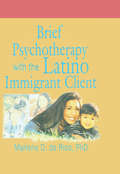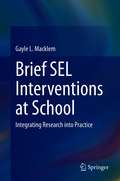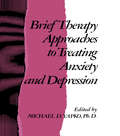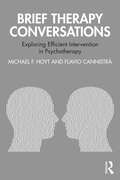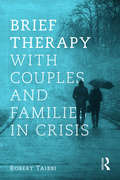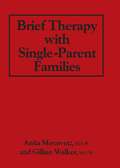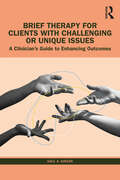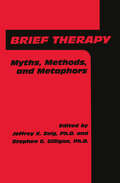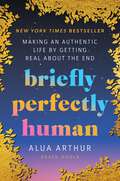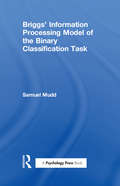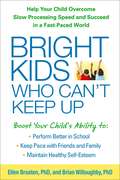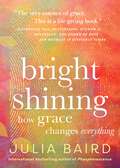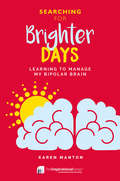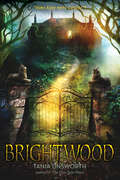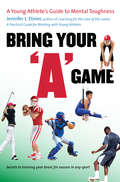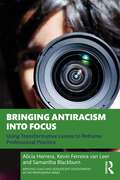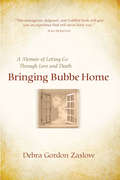- Table View
- List View
Brief Psychotherapy with the Latino Immigrant Client
by Marlene D De RiosUnderstand the unique needs, beliefs, and values of your Latino immigrant clients!Brief Psychotherapy with the Latino Immigrant Client is a manual for the practicing psychotherapist or student, with tips on the assessment process and suggested interventions that work efficiently. With this book you will explore the influence of medical anthropological concepts on Latino immigrant populations in North America. The author draws on her experience as both a medical anthropologist and a licensed psychotherapist and on her extensive fieldwork in the Amazon for help in developing psychosociocultural assessments of Spanish-speaking migrants. This valuable book examines which kinds of therapy work for the growing Latino immigrant population and looks at metaphors (dichos) that can be used to help in brief interventions for clinical issues. In relation to the specific beliefs, values, and sentiments of these clients, Brief Psychotherapy with the Latino Immigrant Client presents: hypnosis techniques that work with this population behavior modification and cognitive restructuring techniques specific culturally appropriate metaphors for distinctive clinical issues an examination of alcohol issues in this population psychological issues that go along with tuberculosis hints for the non-Latino therapist who deals with Latino clients case studies that illustrate the book's principles of care and assessment shamanic techniques of healing that can provide a model for treating these clientsBrief Psychotherapy with the Latino Immigrant Client includes a glossary of Spanish terms, appendixes on hypnotic pain control inductions, sample tests, scales and diagrams, several case studies, and listings of Spanish language resources. Every therapist who treats Latino immigrants should own this book!
Brief SEL Interventions at School: Integrating Research into Practice
by Gayle L. MacklemThis book explores the social-emotional learning (SEL) movement in the United States and the current situation in schools that both supports and impedes the infusion of programs and strategies that actually work for children and adolescents. The volume describes overarching issues to include what the term evidence-based should mean as well as the confusing and sometimes ill-advised proliferation of programs that become components of the many barriers to the success of the SEL movement. The book examines why it may be necessary to take a step back when considering nonacademic interventions in schools. This book explores the need to – and the process of – vetting interventions before trying to implement them in the classroom.In addition, the volume examines the various frameworks and standards involving SEL to shape a thoughtful approach that makes a difference in each student’s academic success. It offers a scientific approach to selecting brief, easy to implement SEL strategies for school psychologists, teachers, and related mental health and educational professionals. The book describes each strategy in detail and addresses how to use these strategies, when to use them, and for whom they are likely to work. The volume concludes recommended implementation and dissemination strategies.This book is a must-have resource for researchers, clinicians/practitioners, and graduate students in child and school psychology, educational psychology, social work as well as all interrelated sub disciplines.
Brief Therapy Approaches to Treating Anxiety and Depression
by Michael D. YapkoMaintaining that most cases of anxiety and depression will respond to intelligently planned brief, directive therapies, Dr. Yapko has assembled this collection of 17 insightful and challenging papers illuminating such brief therapy methods. These innovative essays from such respected practitioners as S.G. Gilligan, J.C. Mills, E.L. Rossi, M.E. Seligman, and others, cover such topics as disturbances of temporal orientation as a feature of depression; the use of multisensory metaphors in the treatment of children's fears and depression; a hypnotherapeutic approach to panic disorder, anxiety as a function of depression; and more.
Brief Therapy Conversations: Exploring Efficient Intervention in Psychotherapy
by Michael F. Hoyt Flavio CannistràBrief Therapy Conversations features stimulating discussions between two international experts about essential topics, including the importance of the therapeutic relationship, the role of diagnosis, the therapist’s mindset, specific techniques and guiding logics, therapist development, and likely future trends. It explores a wide range of literature and ideas on brief therapy and single-session therapy. For those interested in time-sensitive treatment, several expanded journal articles are included that provide additional insights into ways to improve therapeutic efficiency. Reader friendly and conversational in format, this book is essential reading for professionals involved in brief therapy research, teaching, and practice..
Brief Therapy With Couples and Families in Crisis
by Robert TaibbiAs the average length of therapy shortens, clinicians need a resource to lead them step-by-step through the goals and process of the opening sessions of brief therapy as well as clear treatment maps for the most common presenting problems. This resource helps clinicians do just that and more, including doing a quick assessment and isolating and addressing the underlying emotional wounds that prevent families and couples from solving problems on their own. Readers will not only learn how to "think brief," they will also discover how to navigate the session process in an interactive and action-oriented way, even with clients who are in high-pressure, crisis situations.
Brief Therapy With Single-Parent Families
by Anita Morawetz Gillian WalkerFirst published in 1984. Routledge is an imprint of Taylor & Francis, an informa company.
Brief Therapy and Beyond: Stories, Language, Love, Hope, and Time
by Michael F. HoytBrief Therapy and Beyond is a collection of new and selected papers by prominent psychologist Michael Hoyt. Numerous clinical vignettes and informative discussions describe time-sensitive treatments to relieve psychological distress and/or promote growth. Drawing from an encyclopedic knowledge of the professional literature as well as humor, poetry, sports, and candid revelation, Hoyt illustrates the importance of stories, language, love, hope, and time in shaping worldviews that inspire and empower clients and clinicians to make effective and efficient changes.
Brief Therapy for Clients with Challenging or Unique Issues: A Clinician’s Guide to Enhancing Outcomes
by Saul A. SingerBrief Therapy for Clients with Challenging or Unique Issues offers clinicians, interns, and students a unique look into the creative and effective application of foundational concepts and innovative clinical processes that lead to successful outcomes with even the most challenging clients. Chapters illustrate complex interventions such as those involving clients court ordered or coerced into therapy, first-generation immigrant families in the criminal justice system, families at risk of losing custody of their children, foster children in the child welfare system, clients of multigenerational poverty, and families requiring in-home family therapy, and more. Each of these includes moment-by-moment co-constructive processes that document effective intervention ideas and strategies. Rich in neurolinguistics, innovative approaches, and the application of advanced solution-oriented strategies, Brief Therapy for Clients with Challenging or Unique Issues weaves together the stories of courageous clients and offers innovative tools that empower and motivate even the most reluctant clients to engage and identify solutions that fit for them.
Brief Therapy: Myths, Methods, And Metaphors
by Jeffrey K. Zeig Stephen G. GilliganA tapestry of rich and varied perspectives drawn from a remarkable event. The Brief Therapy Congress, sponsored by the Milton H. Erickson Foundation, brought together over 2200 therapists and an impressive faculty that included J. Barber, J. Bergman, S. Budman, G. Cecchin, N. Cummings, S. de Shazer, A. Ellis, M. Goulding, J. Gustafson, J. Haley, C. Lankton, S. Lankton, A. Lazarus, C. Madanes, W. O'Hanlon, P. Papp, E. Polster, E. Rossi, P. Sifneos, H. Strupp, P. Watzlawick, J. Weakland, M. Yapko and many more.
Briefly Perfectly Human: Making an Authentic Life by Getting Real About the End
by Alua ArthurNEW YORK TIMES BESTSELLERA deeply transformative memoir that reframes how we think about death and how it can help us lead better, more fulfilling and authentic lives, from America’s most visible death doula."A truly unique, inspiring perspective on the time we have, what we do with it, and how we let go of this world.... There is no one I'd trust more to guide me through an understanding of death, and how it informs life." — Jodi Picoult, New York Times bestselling author of Mad Honey and The Book of Two Ways"Briefly Perfectly Human is a beautiful, raw, light-bringing experience. Alua's voice is shimmering, singular, and pulses with humor, vulnerability, insight, and refreshing candor.... Be prepared for it to grab you, hold you tight, and raise the roof on the power of human connection." — Tembi Locke, author of From Scratch: A Memoir of Love, Sicily, and Finding HomeFor her clients and everyone who has been inspired by her humanity, Alua Arthur is a friend at the end of the world. As our country’s leading death doula, she’s spreading a transformative message: thinking about your death—whether imminent or not—will breathe wild, new potential into your life.Warm, generous, and funny AF, Alua supports and helps manage end-of-life care on many levels. The business matters, medical directives, memorial planning; but also honoring the quiet moments, when monitors are beeping and loved ones have stepped out to get some air—or maybe not shown up at all—and her clients become deeply contemplative and want to talk. Aching, unfinished business often emerges. Alua has been present for thousands of these sacred moments—when regrets, fears, secret joys, hidden affairs, and dim realities are finally said aloud. When this happens, Alua focuses her attention at the pulsing center of her clients’ anguish and creates space for them, and sometimes their loved ones, to find peace.This has had a profound effect on Alua, who was already no stranger to death’s periphery. Her family fled a murderous coup d’état in Ghana in the 1980s. She has suffered major, debilitating depressions. And her dear friend and brother-in-law died of lymphoma. Advocating for him in his final months is what led Alua to her life’s calling. She knows firsthand the power of bearing witness and telling the truth about life’s painful complexities, because they do not disappear when you look the other way. They wait for you.Briefly Perfectly Human is a life-changing, soul-gathering debut, by a writer whose empathy, tenderness, and wisdom shimmers on the page. Alua Arthur combines intimate storytelling with a passionate appeal for loving, courageous end-of-life care—what she calls “death embrace.” Hers is a powerful testament to getting in touch with something deeper in our lives, by embracing the fact of our own mortality. “Hold that truth in your mind,” Alua says, “and wondrous things will begin to grow around it.”
Briggs' Information Processing Model of the Binary Classification Task
by S. MuddFirst published in 1983. Routledge is an imprint of Taylor & Francis, an informa company. This monograph is a review of the evolution of George Briggs’ informationprocessing model from a general schema beginning with the work of Saul Sternberg (1969a) and Edward E. Smith (1968) to a fairly well-detailed schematic representation of central processes that Briggs was working on at the time of his early death. The development of Briggs’ model of the binary classification task (BCT) spanned the period from 1969 when he published his first report on choice reaction time with Blaha (Briggs & Blaha, 1969) to 1977 with the publication of a posthumous paper (Briggs, Thomason, & Hagman, 1978). The model evolved across a total of 16 experimental and 2 review papers.
Bright Kids Who Can't Keep Up
by Ellen Braaten Brian WilloughbyDo you find yourself constantly asking your child to "pick up the pace"? Does he or she seem to take longer than others to get stuff done--whether completing homework, responding when spoken to, or getting dressed and ready in the morning? Drs. Ellen Braaten and Brian Willoughby have worked with thousands of kids and teens who struggle with an area of cognitive functioning called "processing speed," and who are often mislabeled as lazy or unmotivated. Filled with vivid stories and examples, this crucial resource demystifies processing speed and shows how to help kids (ages 5 to 18) catch up in this key area of development. Helpful practical tools can be downloaded and printed in a convenient 8 1/2" x 11" size. Learn how to obtain needed support at school, what to expect from a professional evaluation, and how you can make daily routines more efficient--while promoting your child's social and emotional well-being.
Bright Kids Who Couldn't Care Less: How to Rekindle Your Child's Motivation
by Ellen Braaten&“He&’s so smart, but he&’s no longer interested in school--or any 'offline' activities.&” &“She used to love sports, but now she just mopes around.&” &“My kid has turned into such a slacker!&” Sound familiar? If you're wondering how your bright, motivated little kid became such an unmotivated adolescent, you're not alone. Fortunately, help is at hand! In this compassionate guide, psychologist and learning expert Ellen Braaten explains that kids who have lost the will to do anything (other than play video games) need more than simple encouragement or the &“right&” school, teacher, or coach to get back on track. Instead, Dr. Braaten helps you understand the myriad biological, psychological, and social factors that affect motivation, and get to know your own child's unique strengths, weaknesses, and personality traits better. Gain vital tools for tackling the motivational problems that are so pervasive today--and build a plan to boost your child&’s confidence and engagement in life.
Bright Minds, Poor Grades
by Michael D. WhitleyIn addition to outlining the importance of teaching a child to love labor, Whitley provides a ten-step program to help parents motivate the bright child who prefers to work below ability. A clear, concise, useful book.
Bright Shining: How Grace Changes Everything
by Julia Baird'A powerful book from one of my favorite writers on something we all need more of...and could give more of.' — Ryan Holiday, bestselling author of The Obstacle is the Way and Ego Is the Enemy“Luminous. . . . A work to both devour and savour, Baird has, once again, written a book the world needs now.'”—GuardianFrom the bestselling author of Phosphorescence comes a beautiful and timely exploration of that most mysterious but necessary of human qualities: grace.Grace is hard to define. It can be found when we create ways to find meaning and dignity in connection with each other, building on our shared humanity, being kinder, bigger, better with each other. If, in its crudest interpretation, karma is getting what you deserve, then grace is the opposite: forgiving the unforgivable, favoring the undeserving, loving the unlovable.Sadly, we live in an era when grace is increasingly rare. Our growing distrust of the media, politicians, and each other has choked our ability to trust, to accept, to allow for mistakes, to forgive.What does grace look like in today’s world, and how do we recognize it, nurture it in ourselves and express it, even in the darkest of times? In this luminously beautiful, deeply insightful, and timely book, Baird explores the meaning of grace and how we can cut through negativity to find it today.
Bright Splinters of the Mind: A Personal story of research with Autistic Savants
by Beate HermelinThe author describes a series of studies which she and her colleagues have conducted in an attempt to gain a deeper understanding of autistic savant syndrome. Her subjects include children and adults with autism who have remarkable abilities in music, art, mathematics, foreign languages, and calendar calculation. Hermelin suggests that people with autism perceive detail before recognizing an integrated whole. This is a very readable book with a strong scholarly foundation.
Brighter Days: Learning to Manage my Bipolar Brain (Inspirational Series)
by Karen MantonGrowing up in a deprived area of North East England in the 1970’s, alcoholism and violence played a huge role in Karen’s everyday family life. But things were only to become more difficult when, at the age of seventeen, she began her battle with anxiety and depression, an illness nobody recognised. Her reality became a devastating, deteriorating state of existence, and no one seemed to understand what was happening to her.A number of harrowing, recurrent and often bizarre episodes – including a phantom pregnancy, a nightclub assault, and an unhealthy obsession with a celebrity – eventually lead to Karen being sectioned under the mental health act and taken into hospital. It then took years and many more dramatic relapses before doctors would finally give her the correct diagnosis of bipolar disorder.
Brightwood
by Tania Unsworth“Brilliantly conceived . . . entertaining and heartfelt.” —Kirkus Reviews Daisy Fitzjohn knows there are two worlds: the outside world and the world of Brightwood Hall, her home—and the only place she’s ever been. Daisy and her mother have everything they need within its magnificent, crumbling walls. But, when Daisy’s mother leaves unexpectedly one morning, a strange visitor arrives on the estate, claiming to be a distant cousin, James Gritting. As the days tick by and Daisy’s mother doesn’t return, Gritting becomes more and more menacing. He wants Brightwood for himself, and he will do anything to get it—unless Daisy, with only her imaginary companions to help her, can stop him. Tania Unsworth takes readers on a twisting, heart-pounding journey through dark corridors and wild, untamed gardens in this novel perfect for fans of Doll Bones and Coraline.
Brilliancy: The Essence of Intelligence
by A. H. AlmaasIntelligence is one of the defining characteristics of human beings: an inherent ability to respond to the world with awareness, knowledge, learning, and insight. Most considerations of human intelligence are based on the notion that intelligence is a product of brain functioning. A. H. Almaas introduces here a radically different viewpoint, one that recognizes an actual quality of consciousness as the source of intelligence. He calls this source the Brilliancy of our true nature. The presentation of his understanding of intelligence is followed by in-depth dialogues with his students on the various barriers to recognizing and embodying this essential quality. In particular, an unresolved relationship with one's father is found to shape the experience of Brilliancy. Using a Socratic method that draws upon techniques of body-centered, Gestalt, psychodynamic, and cognitive psychologies, Almaas helps participants work through their defenses and conflicts surrounding this issue and then, diverging from pychotherapeutic practice, guides them in discovering their own Brilliancy.
Brincar à Maneira Dinamarquesa
by Iben Dissing SandahlO famoso modelo escandinavo que desperta a felicidade, confiança e espontaneidade das crianças Depois do grande sucesso alcançado pelo bestseller Pais à Maneira Dinamarquesa, a psicoterapeuta e professora Iben Dissing Sandahl aprofunda o que torna a Dinamarca tão especial, um dos pilares mais importantes para educar crianças saudáveis e felizes - a brincadeira livre, não estruturada. Sandhal defende uma sociedade onde prestemos mais atenção à educação de crianças equilibradas e com grande força interior, a fim de melhor as prepararmos para os desafios que as esperam no futuro. Para tal, oferece aos pais e educadores em todo o mundo uma visão sobre como integrar a brincadeira livre na vida das crianças. Um guia prático para brincadeiras livres, não estruturadas, que define claramente as etapas a ter em conta para criar filhos fortes e saudáveis. Com tópicos práticos e exemplos inspiradores, Brincar à Maneira Dinamarquesa ajudará pais e educadores a tornar as crianças AINDA mais felizes e mais bem integradas. Adira ao Juramento da Brincadeira e ofereça às crianças a oportunidade de crescerem felizes:«Concordamos com divertir-nos, ser autênticos, experimentar e explorar, deixar a brincadeira captar a magia da imaginação, não julgar nem condenar as ideias dos outros, apreciar a honestidade que a brincadeira desperta, estar abertos à nossa fonte interior de criatividade, e à dos outros.» Os elogios da crítica: «SIM! Vamos pôr de lado todas as estruturas mensuráveis e deixar os nossos filhos brincar à sua maneira para encontrarem o caminho para uma vida feliz e consistente, a fim de poderem conquistar o mundo da forma mais pacífica.»Tom C, Pai «Este livro torna fácil entender o tesouro escondido da brincadeira. Dá uma valiosa perspectiva de como a brincadeira das crianças as ajuda a desenvolver-se como seres humanos e diz a nós, pais, quando nos afastarmos e quando interferirmos.»Nicole P., Mãe «Brincar à Maneira Dinamarquesa defende energicamente a brincadeira livre e dá sugestões práticas aos pais, educadores e médicos para a sua implementação. Concordo que a liberdade de resolver conflitos, medos, e exprimir criatividade só pode ajudar a reduzir o stress, a aumentar a autoconfiança, a diversão, as competências para resolver problemas e a resiliência.»Barbara Lavine, conselheira profissional licenciada, Virginia, EUA «Antes de ter lido Brincar à Maneira Dinamarquesa, não me tinha apercebido de quanto brincar de forma não estruturada é importante. Brincar é a forma de as crianças desenvolverem um espírito inovador, sociável e feliz. Brincar é a forma de pensar criativa que muitos de nós perdem demasiado cedo. É o que faz os seres humanos continuarem e criar e a inovar. Apresenta ao leitor ideias concretas de como proporcionar uma vida mais lúdica e mais feliz às crianças e às suas famílias.»Line West, happyasadane.com «O livro de Iben Sandahl sobre a brincadeira livre das crianças insiste que devemos estar atentos à forma como a brincadeira cria a sua magia, que a deixemos desenrolar-se em linhas individuais de oportunidade, que encorajemos as crianças a brincar e que façamos parte disso. Brincar à maneira dinamarquesa contém uma mensagem importante, com as suas ideias e sugestões sobre como garantir às crianças a brincadeira livre num mundo que se foca sobretudo nos requisitos de desempenho. Algo que podemos garantir reconhecendo como brincar livremente fortalece o desenvolvimento das crianças enquanto seres humanos e incentiva-as a testar as suas oportunidades tanto no mundo real como no imaginário.»Per Schultz Jorgensen, professor emérito, doutor em Filosofia «Brincar à Maneira Dinamarqu
Bring Me to Light: Embracing My Bipolar and Social Anxiety (Inspirational Series)
by Eleanor SegallEleanor Segall's life was beginning. An aspiring actress and a family girl, she never thought her future would be derailed by mental illness. After a spate of depressive episodes, panic attacks and social anxiety, Eleanor found herself in The Priory at age 16. The diagnosis? Bipolar affective disorder.But Eleanor didn't let it stop her for long. Now a successful blogger, journalist, and pillar of the mental health and Jewish communities, she writes about finding recovery and hope after being unwell. Her story is of picking herself back up again and surviving against the odds. It will resonate with many - and it can help them find that light in the darkness too.
Bring Your "A" Game: A Young Athlete's Guide to Mental Toughness
by Jennifer L. EtnierMental training is just as important as physical training when it comes to success in sport. And like physical fitness, mental toughness is something that can be taught and learned. Yet many young athletes have not learned the psychological skills needed to develop their best game. This book was written specifically for young athletes interested in improving their performance and reaching their potential in sport. Bring Your "A" Gameintroduces key strategies for mental training, such as goal setting, pre-performance routines, confidence building, and imagery. Each of the seventeen chapters focuses on a single mental skill and offers key points and exercises designed to reinforce the concepts. The book encourages athletes to incorporate these mental skills into their daily lives and practice sessions so that they become second nature during competition. Whether used at home by student athletes or assigned by coaches as part of team development,Bring Your "A" Gamewill help young performers develop a plan for success and learn to deal with the challenges of pursuing excellence in sport.
Bringing Antiracism into Focus: Using Transformative Lenses to Reframe Professional Practice (Applying Child and Adolescent Development in the Professions Series)
by Alicia Herrera Kevin Ferreira van Leer Samantha BlackburnThis guide introduces applied antiracist developmental science and developmental frameworks that have been comprehensively integrated with antiracist principles. It underscores the importance of viewing child and adolescent development‑related work through an antiracist lens from the outset, examining how systemic racism, implicit bias, and critical consciousness shape human development, and emphasizes the need to cultivate an antiracist developmental perspective to promote equity in professional settings.Anchored in the foundational bioecological model, this book extends to additional frameworks such as the Racism + Resilience + Resistance Integrative Study of Childhood Ecosystem (R³ISE), the Integrative Model of Ethnic Minority Development, the Multicontextual Model for Diverse Learning Environments, and the Phenomenological Variant of Ecological Systems Theory (PVEST). These frameworks are adapted to confront racism and support antiracist practices.Targeted discussions in dedicated chapters cover fields including psychology, PK‑12 education, higher education, and allied health. This book bridges theory and practice through case studies, practical examples, and reflective activities, demonstrating how to incorporate antiracist strategies into daily professional practice. It also delves into how community assets can be protective and mitigate the effects of racism, guiding professionals to recognize and leverage these strengths effectively.This resource is designed for students, pre‑professionals, and early‑career professionals in child and adolescent development committed to incorporating antiracist practices into their work. It serves as both an introductory overview and a practical manual for applying developmental principles with an emphasis on reflection and praxis.
Bringing Bubbe Home
by Debra Gordon ZaslowDebra Zaslow was humming along on baby-boomer autopilot, immersed in her life as a professional storyteller, wife of a Rabbi, and mother of two teenagers when she felt compelled to bring her 103-year-old grandmother, Bubbe, who was dying alone in a nursing facility, home to live and die with her family. Zaslow had no idea if she would have the emotional stamina to midwife Bubbe to the other side. Bringing Bubbe Home is the story of their time together in Bubbe’s last months, mingled with scenes from the past that reveal how her grandmother’s stories of abuse, tenacity, and survival have played out through the generations of women in the family. Debra watches her expectations of a perfect death dissolve in the midst of queen-size diapers, hormonal teenagers and volatile caregivers, while the two women sit soul-to-soul in the place between life and death. As she holds her grandmother’s gnarled hand and traces the lines of her face, Debra sees her own search for mothering reflected in her grandmother’s eyes. When Bubbe finally dies, something in Debra is born: the possibility to move into the future without the chains of the past.
Bringing Bubbe Home
by Debra Gordon ZaslowDebra Zaslow was humming along on baby-boomer autopilot, immersed in her life as a professional storyteller, wife of a Rabbi, and mother of two teenagers when she felt compelled to bring her 103-year-old grandmother, Bubbe, who was dying alone in a nursing facility, home to live and die with her family. Zaslow had no idea if she would have the emotional stamina to midwife Bubbe to the other side.Bringing Bubbe Home is the story of their time together in Bubbe's last months, mingled with scenes from the past that reveal how her grandmother's stories of abuse, tenacity, and survival have played out through the generations of women in the family. Debra watches her expectations of a perfect death dissolve in the midst of queen-size diapers, hormonal teenagers and volatile caregivers, while the two women sit soul-to-soul in the place between life and death. As she holds her grandmother's gnarled hand and traces the lines of her face, Debra sees her own search for mothering reflected in her grandmother's eyes. When Bubbe finally dies, something in Debra is born: the possibility to move into the future without the chains of the past.
